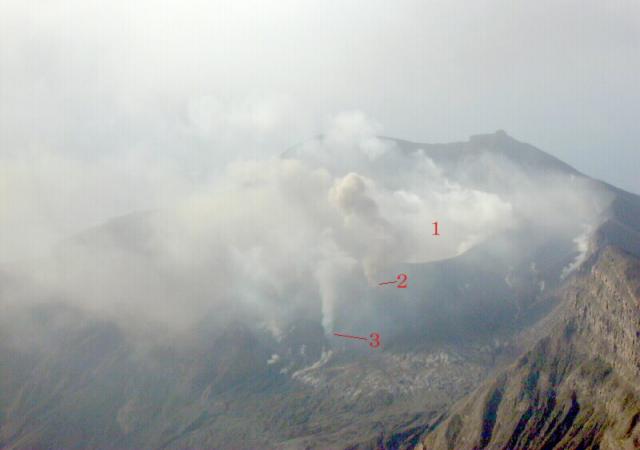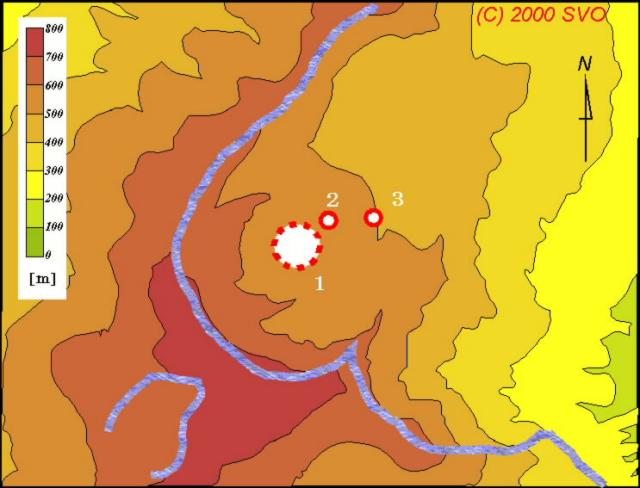Report on Suwanosejima (Japan) — February 2001
Bulletin of the Global Volcanism Network, vol. 26, no. 2 (February 2001)
Managing Editor: Richard Wunderman.
Suwanosejima (Japan) Two subsidiary craters discovered; elevated activity in December 2000
Please cite this report as:
Global Volcanism Program, 2001. Report on Suwanosejima (Japan) (Wunderman, R., ed.). Bulletin of the Global Volcanism Network, 26:2. Smithsonian Institution. https://doi.org/10.5479/si.GVP.BGVN200102-282030
Suwanosejima
Japan
29.638°N, 129.714°E; summit elev. 796 m
All times are local (unless otherwise noted)
An observer on Suwanose-jima reported seeing "smoke" rise from NE of the summit crater at about 1700 on 19 December 2000. The following day, Kazuhiro Ishihara from Sakura-jima Volcano Research Center (SVRC, formerly Sakura-jima Volcano Observatory, SVO) of Kyoto University inspected the crater area during a helicopter flyover. He observed an ash-laden, high-temperature gas emission from the main active crater, On-take, and from two newly formed craters on the outer NE slope of the main crater (figures 2 and 3).
 |
Figure 3. Photo of the NE slope of Suwanose-jima showing the main active crater (1), On-take, and two subsidiary craters (2, 3). Courtesy of SVRC. |
Subsequent observations on 24 December by Masato Iguchi and Daisuke Miki, both of SVRC, revealed more about the nature of the craters' activities. Craters 2 and 3 were ~40 m and ~200 m away from the main crater rim, respectively. Crater 2 had a diameter of ~25 m, and crater 3 had a diameter of ~10 m. The craters were thermally surveyed from a helicopter. On-take (crater 1) had a temperature of ~450°C, and emitted light-colored vapor. Crater 2 released an ash-laden plume and had a temperature of ~100°C. Crater 3, which had a temperature of ~270°C, ejected gas and a small amount of ash.
Seismicity recorded by SVRC showed that ~10 deep volcanic (A-type) earthquakes occurred monthly, an increase since fall 1999. Shallow volcanic (B-type) earthquakes had also increased since early 2000 with the occurrence of ~50-300 events monthly. Researchers using GPS techniques discovered that deformation had increased the distance between Suwanose-jima and Nakano-shima, a neighboring island, by 1 cm. SVRC indicated that activity was elevated, but that it did not imply an immediate large-scale eruption.
Geological Summary. The 8-km-long island of Suwanosejima in the northern Ryukyu Islands consists of an andesitic stratovolcano with two active summit craters. The summit is truncated by a large breached crater extending to the sea on the E flank that was formed by edifice collapse. One of Japan's most frequently active volcanoes, it was in a state of intermittent Strombolian activity from Otake, the NE summit crater, between 1949 and 1996, after which periods of inactivity lengthened. The largest recorded eruption took place in 1813-14, when thick scoria deposits covered residential areas, and the SW crater produced two lava flows that reached the western coast. At the end of the eruption the summit of Otake collapsed, forming a large debris avalanche and creating an open collapse scarp extending to the eastern coast. The island remained uninhabited for about 70 years after the 1813-1814 eruption. Lava flows reached the eastern coast of the island in 1884. Only about 50 people live on the island.
Information Contacts: Disaster Prevention Research Institute, Kyoto University (URL: http://www.dpri.kyoto-u.ac.jp/); Setsuya Nakada and Hidefumi Watanabe, Volcano Research Center, Earthquake Research Institute, University of Tokyo, Yayoi 1-1-1, Bunkyo-ku, Tokyo 113-0032, Japan (URL: http://www.eri.u-tokyo.ac.jp/VRC/index_E.html).


